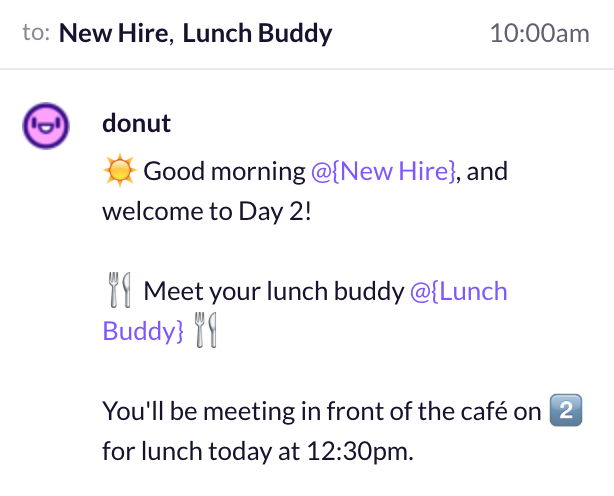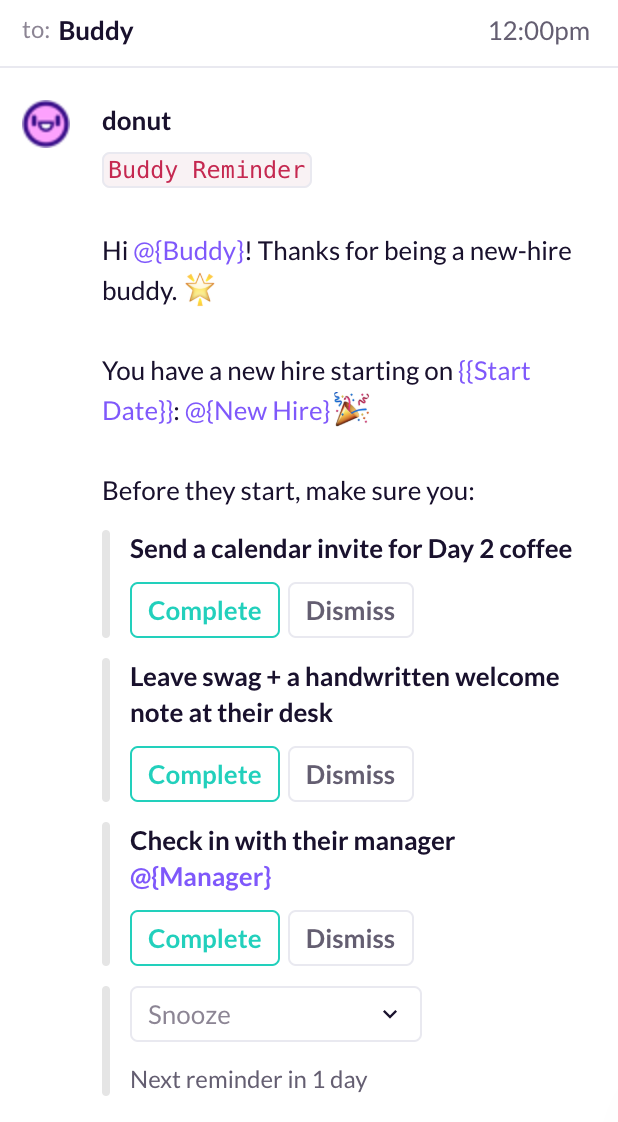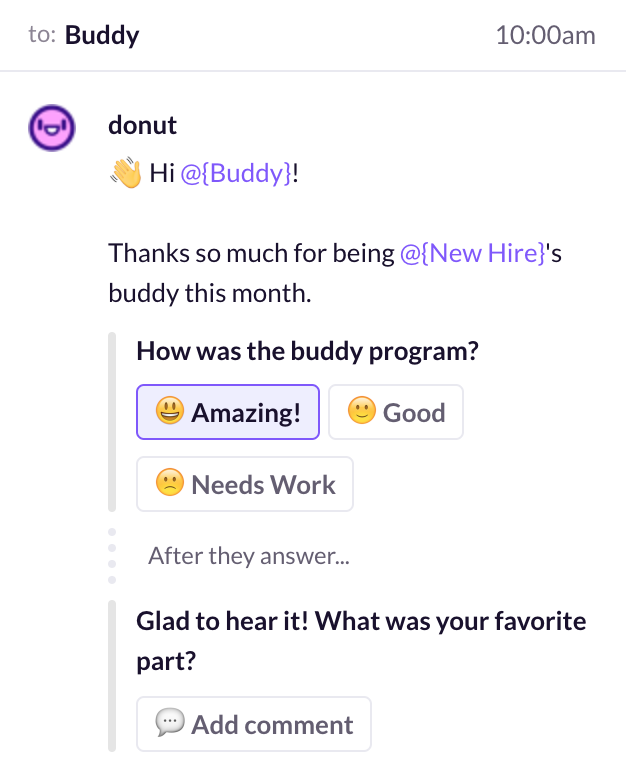A well-run buddy system is one of the most impactful things you can add to the new hire onboarding experience. Buddies serve as an important source of institutional and role-specific knowledge that can lessen the load on managers and help new hires ramp faster. Even better, they help to create an instant sense of belonging and social connections for new hires, which pays huge dividends in terms of retention.
Though buddy systems take time and thought to administer, the ROI of a decreased ramp time and increased retention makes them worth it in the long run. Gallup found that employees with strong social connections are seven times more likely to be engaged—and that any gains in social cohesiveness corresponded to even higher gains in productivity.
What does a best-in-class buddy system look like? We’ve chatted with hundreds of teams about what makes for an impactful buddy program, and here’s what we’ve learned.
Step 1: Create a pool of buddy volunteers
Before you launch a buddy program, you’ll need to round up some volunteers with the time and enthusiasm to help welcome new hires to the team. As you’re recruiting, consider factors like diversity, length of tenure, role-specific knowledge, and above all the desire to serve as a buddy. The best buddies are the ones that want to be doing the job.
Here are some recruiting tactics we’ve seen that work
- Send a team-wide email or post in a Slack channel like #general calling for volunteers
- At the end of new hire onboarding, ask the now-ramped new hire if they’d like to serve as a buddy for an incoming new hire.
- Ask managers to nominate buddies from each department.
Step 2: Provide training and set expectations for buddies
Great buddies are made, not born. Even the most friendly and enthusiastic employees can use a few pointers and guidelines to help clarify responsibilities and set the tone for the relationship. Structured programs tend to perform better over time than informal buddy systems, so it’s worth investing in a little upfront education like:
- Create a checklist of tasks or duties so buddies know what to expect.
- Schedule a training to cover the checklist and answer questions.
- Set expectations clearly: Communicate the expected time commitment, the knowledge they should be prepared to share or meetings they should be scheduling, housekeeping tasks like assembling a swag kit or setting up a desk, etc.
Step 3: Use different kinds of buddies to fill specific needs

All-purpose onboarding buddies are a great first step, but specialized ones can have a powerful impact. Have you collected feedback on the new hire experience? Identify gaps like social belonging, cross-team connection, or role-specific knowledge, and use specialized buddies to plug the gaps. Some common buddy types include:
- Lunch buddy: Have the lunch buddy (or buddies!) acclimate the new hire to lunch culture on your team by taking them to lunch or arranging other lunches for them during their first days or weeks.
- Coffee buddy: Much like a lunch buddy, coffee buddy (or buddies!) are perfect for a nice mid-afternoon break, and a low-pressure way to get to know people across different teams.
- Mentor: Assigning new hires to a mentor is a way for them to level up and grow both personally and professionally. It’s a big value-add, and a relationship that can be built over a period of months (or years).
- In-department buddy: Want to know where the marketing team stores their knowledge or dive into the code base? In-department buddies take the pressure off managers to train new hires, and provide valuable leadership opportunities for individual contributors on different teams.
- Social connectors: Social connectors are the hub for meet-and-greets. They know the new hire’s role, and can independently connect them to everyone that they need to know in order to be successful in their roles.
Step 4: Send reminders that set buddies up for success

Approximately 0% of teams that we work with hire full-time onboarding buddies. That means that 100% of buddies have demanding full-time roles outside of being a buddy for new hires. While they might be enthusiastic participants, nudges and support will undoubtedly help them to fulfill the expectations of their role successfully. How to enable that?
- Remind the buddy of the new hire’s start date, name, and any relevant info beforehand.
- Prompt buddies to go the extra mile and create moments of delight for new hires. Buddies can set up the new hire’s desk, pick them up at reception, or put together a swag kit with a handwritten welcome note.
- Thank the buddy for their time and efforts! A little appreciation pays big dividends.
Step 5: Introduce the new hire and their buddy
Break the ice for the new hire and their onboarding buddy by making an introduction, and including a prompt for what they should do. The best introductions set expectations while creating some enthusiasm. GIFs and emojis are your friends. Intros can take place:
- Via Slack
- Via email
- In person, after orientation or when the new hire first arrives
Step 6: Create natural checkpoints
Even the most well-intentioned buddy programs can start to fail if they’re on auto-pilot. Building in regular accountability check-ins will help keep the program consistently valuable.
Need some inspiration? Here are a few specific tasks you can give buddies that are worth a nudge:
- Remind them to schedule meetings or check in with their buddy regularly over the course of their first week/month/90 days.
- Feed them conversation topics, tips, or questions to ask the new hire.
- Give them specific jobs, like connecting the new hire to anyone that might be important for them to know in their role.
Step 7: Collect feedback and iterate

The best programs aren’t built in a day: They’re carefully iterated over time. The best way to inspire those iterations? By collecting feedback from everyone involved.
- Send periodic quick-pulse polls to buddies and new hires separately asking how it’s going.
- Ask managers how buddy programs are going from a ramping perspective, and what could make them more valuable.
- Distribute longer-form surveys at the end of onboarding to both buddies and new hires.
Rome wasn’t built in a day
If your mind is whirring with buddy system possibilities but you already have a long to-do list, we repeat: Rome wasn’t built in a day.
Whether you’re a people ops team of 1 or have a headcount for onboarding specifically, you can add 1-2 things to your buddy repertoire that feel pretty painless but pay big dividends.
If you’re first diving in…
Run a one-match buddy system with a pool of volunteers, and create a Slack channel where you can post general reminders and prompts that reach an entire new hire class at once.
Introduce the new hire to their buddy on the first day, and set the expectation that they’ll be going to lunch or coffee together at some point.
Collect feedback at the end of the process.
If you’re already running a buddy system…
Layer in periodic trainings for new volunteers, and consider adding a role-specific buddy assigned by the manager to tackle more specialized knowledge and trainings.
Add a check-in at 30 days to see how the system is going.
If you’re taking your amazing existing program to the next level…
Match primary buddies based on specific compatibility or experience criteria, and add in different lunch and coffee buddies so new hires are meeting people across the organization.
Add periodic feedback and accountability check-ins for both the new hires and buddies so you can get insights into the program and continuously iterate.
